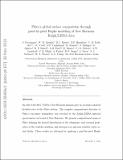| dc.contributor.author | Protopapa, S. | |
| dc.contributor.author | Grundy, W.M. | |
| dc.contributor.author | Reuter, D.C. | |
| dc.contributor.author | Hamilton, D.P. | |
| dc.contributor.author | Dalle Ore, C.M. | |
| dc.contributor.author | Cook, J.C. | |
| dc.contributor.author | Cruikshank, D.P. | |
| dc.contributor.author | Schmitt, B. | |
| dc.contributor.author | Philippe, S. | |
| dc.contributor.author | Quirico, E. | |
| dc.contributor.author | Binzel, Richard P | |
| dc.contributor.author | Earle, A. M. | |
| dc.contributor.author | Ennico, K. | |
| dc.contributor.author | Howett, C.J.A. | |
| dc.contributor.author | Lunsford, A.W. | |
| dc.contributor.author | Olkin, C.B. | |
| dc.contributor.author | Parker, A. | |
| dc.contributor.author | Singer, K.N. | |
| dc.contributor.author | Stern, A. | |
| dc.contributor.author | Verbiscer, A.J. | |
| dc.contributor.author | Weaver, H.A. | |
| dc.contributor.author | Young, L.A. | |
| dc.contributor.author | New Horizons Science Team | |
| dc.date.accessioned | 2020-08-31T21:24:35Z | |
| dc.date.available | 2020-08-31T21:24:35Z | |
| dc.date.issued | 2017-05 | |
| dc.date.submitted | 2016-10 | |
| dc.identifier.issn | 0019-1035 | |
| dc.identifier.uri | https://hdl.handle.net/1721.1/126851 | |
| dc.description.abstract | On July 14th 2015, NASA's New Horizons mission gave us an unprecedented detailed view of the Pluto system. The complex compositional diversity of Pluto's encounter hemisphere was revealed by the Ralph/LEISA infrared spectrometer on board of New Horizons. We present compositional maps of Pluto defining the spatial distribution of the abundance and textural properties of the volatiles methane and nitrogen ices and non-volatiles water ice and tholin. These results are obtained by applying a pixel-by-pixel Hapke radiative transfer model to the LEISA scans. Our analysis focuses mainly on the large scale latitudinal variations of methane and nitrogen ices and aims at setting observational constraints to volatile transport models. Specifically, we find three latitudinal bands: the first, enriched in methane, extends from the pole to 55°N, the second dominated by nitrogen, continues south to 35°N, and the third, composed again mainly of methane, reaches 20°N. We demonstrate that the distribution of volatiles across these surface units can be explained by differences in insolation over the past few decades. The latitudinal pattern is broken by Sputnik Planitia, a large reservoir of volatiles, with nitrogen playing the most important role. The physical properties of methane and nitrogen in this region are suggestive of the presence of a cold trap or possible volatile stratification. Furthermore our modeling results point to a possible sublimation transport of nitrogen from the northwest edge of Sputnik Planitia toward the south. | en_US |
| dc.language.iso | en | |
| dc.publisher | Elsevier BV | en_US |
| dc.relation.isversionof | http://dx.doi.org/10.1016/j.icarus.2016.11.028 | en_US |
| dc.rights | Creative Commons Attribution-NonCommercial-NoDerivs License | en_US |
| dc.rights.uri | http://creativecommons.org/licenses/by-nc-nd/4.0/ | en_US |
| dc.source | arXiv | en_US |
| dc.title | Pluto’s global surface composition through pixel-by-pixel Hapke modeling of New Horizons Ralph/LEISA data | en_US |
| dc.type | Article | en_US |
| dc.identifier.citation | Protopapa, S. et al. "Pluto’s global surface composition through pixel-by-pixel Hapke modeling of New Horizons Ralph/LEISA data." Icarus 287 (May 2017): 218-228 © 2016 Elsevier Inc | en_US |
| dc.contributor.department | Massachusetts Institute of Technology. Department of Earth, Atmospheric, and Planetary Sciences | en_US |
| dc.relation.journal | Icarus | en_US |
| dc.eprint.version | Author's final manuscript | en_US |
| dc.type.uri | http://purl.org/eprint/type/JournalArticle | en_US |
| eprint.status | http://purl.org/eprint/status/PeerReviewed | en_US |
| dc.date.updated | 2019-09-26T13:08:26Z | |
| dspace.date.submission | 2019-09-26T13:08:33Z | |
| mit.journal.volume | 287 | en_US |
| mit.metadata.status | Complete | |
